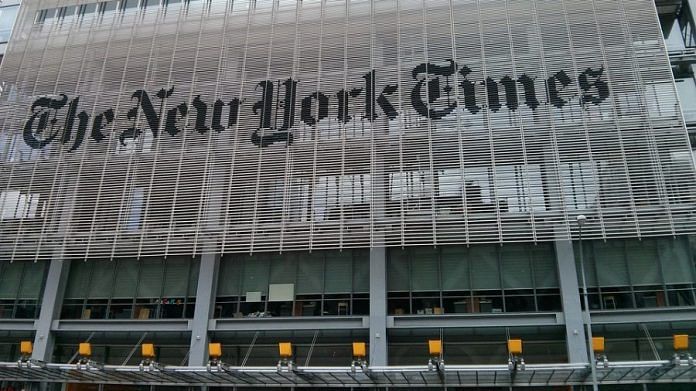New Delhi: Indian cartoonists are stunned by The New York Times’ decision to scrap political cartoons in its international editions.
The NYT had Monday announced that it would no longer be publishing political cartoons, thus “bringing that (international) edition in line with the domestic paper”, which doesn’t carry political cartoons at all.
“We plan to continue investing in forms of Opinion journalism, including visual journalism, that express nuance, complexity, and strong voice from a diversity of viewpoints across all of our viewpoints,” reads the statement by editorial page editor James Bennett.
Although the statement makes no mention of it, the move comes over a month after NYT drew sharp criticism and condemnation for carrying an anti-semitic cartoon of Israeli Prime Minister Benjamin Netanyahu.
The decision has shocked Indian cartoonists.
E.P. Unny, a long-time cartoonist with The Indian Express, called the NYT’s decision “regressive”.
“Before cartoons are published, they always go through editorial insight,” Unny told ThePrint. “That they (NYT) have decided to do away with political cartoons altogether is an extremely regressive decision. It’s surprising that they would do such a thing.”
R. Prasad, who illustrates for The Economic Times, seconded this. “What NYT has done is an overreaction,” he said.
Indian cartoon space thriving
Patrick Chappatte and Heng Kim Song, both illustrators for the NYT, are likely to suffer most from the publication’s decision. In a blog post, Chapette expressed his disappointment, writing, “this is not just about cartoons, but about journalism and opinion in general. We are in a world where moralistic mobs gather on social media and rise like a storm, falling upon newsrooms in an overwhelming blow.”
Indian cartoonists agree that media houses are under pressure but for reasons that are perhaps the inverse of what Chapette speaks of.
In India, it is politicians and people in positions of power — not Twitterati — who pose a greater threat to the freedom of speech.
On 10 May, the Mamata Banerjee government in West Bengal jailed a woman for sharing a morphed image of the Trinamool Congress chief on social media. As of today, at least five people have been arrested for having shared “objectionable” content about Uttar Pradesh chief minister Yogi Adityanath.
Despite this, however, cartoonists don’t feel as though their jobs are under threat, and are in fact optimistic about the future of political cartoons.
“Better newspapers in India allow cartoonists a free hand,” said Unny. “Even if the state of journalism in India is not as robust as in the US, cartoons remain that one space for unfiltered critique.”
R. Prasad agreed. “In India, no paper has removed a cartoonist,” he said. “All the major publications have one, sometimes two, three cartoon columns. They’re still immensely popular and well-respected.”
Also read: How social media memes became a political weapon to woo first-time voters
Censorship
A cartoonist’s relationship with censorship is in constant limbo, explained Prasad. “Censorship exists everywhere,” he said. “No matter what publication you work for, there will be some holy cows that you cannot touch. But our job is to negotiate through that. Editorial might push, and we push back,” he added.
“Having the editorial insight is a gain, by and large. It saves us from self-censorship. We can feel confident about what we have produced. It also becomes easier to fight a court case if we have a publication behind us.”
Standards of what is deemed appropriate and what isn’t, however, is under constant change. Satish Acharya, an illustrator formerly with Mail Today, quit in 2018 after the daily refused to run his illustration showing China’s talons spreading across Asia.
He wrote in a Facebook post in August 2018 that this instance was the last straw, with others preceding it.
“I have been battling to protect my freedom, to protect the sanctity of a cartoon column, for many days. Maybe for the editor, it’s just three column space, but for a cartoonist, it’s a whole world,” he wrote. “I was rudely reminded that the space is owned by the editor, the paper.”
Times are a-changin’
In her book Caricaturing Culture in India, Ritu Gairola Khanduri observed that newspaper cartoons are always a peripheral, rather than central, component of a newspaper’s editorial.
Sandeep Adhwaryu, who illustrates for The Times of India, agreed. “For a publication, the cartoon section becomes the most dispensable if it is attracting too much ire,” he said. This is worsened in a “polarised” world, which is how Adhwaryu sees the state of affairs in India, and beyond.
“Cartoonists favour no one. Our job is to critique the Left, the Right, liberals, conservatives, the government, private parties, everyone,” Adhwaryu said. “But it also means we’re attacked by all sides. If a publication doesn’t stand by our work, it becomes a thankless job,” he added.
“We’re faced with an extremely polarised atmosphere here in India, making it difficult to take a neutral stand.”
Even as publications may buckle under pressure — either from the government or an uproar on social media — the rise of the internet is making the exchange of political cartoons more democratic, a phenomenon welcomed by cartoonists.
“Because of the ability of cartoons to go viral (online), newspapers are showing more interest in cartoons,” Acharya told ThePrint over email. “As many newspapers have digital avatars too, they use cartoons extensively,” he said.
“The 21st century is poised for a huge creative leap. Political art is becoming more accessible,” Unny said. “The world is becoming more visual, and people are engaging in dialogue more through images. I think NYT emerges the loser among all these changes.”
Also read: Ambedkar knew about cartoons trolling him and he blamed ‘Congress Press’ for it




The case for better cartoon sensibility is best argued by not referring cartoons as illustrations and cartoonists as illustrators.